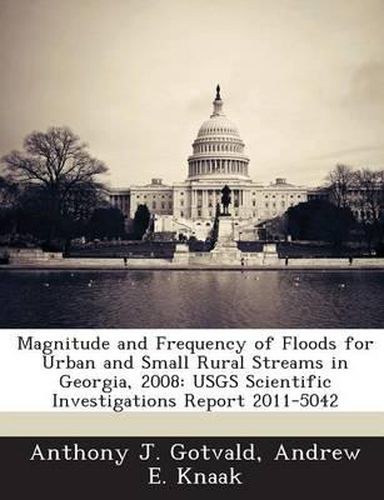Readings Newsletter
Become a Readings Member to make your shopping experience even easier.
Sign in or sign up for free!
You’re not far away from qualifying for FREE standard shipping within Australia
You’ve qualified for FREE standard shipping within Australia
The cart is loading…






A study was conducted that updated methods for estimating the magnitude and frequency of floods in ungaged urban basins in Georgia that are not substantially affected by regulation or tidal fluctuations. Annual peak-flow data for urban streams from September 2008 were analyzed for 50 streamgaging stations (streamgages) in Georgia and 6 streamgages on adjacent urban streams in Florida and South Carolina having 10 or more years of data. Flood-frequency estimates were computed for the 56 urban streamgages by fitting logarithms of annual peak flows for each streamgage to a Pearson Type III distribution. Additionally, basin characteristics for the streamgages were computed by using a geographical information system and computer algorithms. Regional regression analysis, using generalized least-squares regression, was used to develop a set of equations for estimating flows with 50-, 20-, 10-, 4-, 2-, 1-, 0.5-, and 0.2-percent annual exceedance probabilities for ungaged urban basins in Georgia. In addition to the 56 urban streamgages, 171 rural streamgages were included in the regression analysis to maintain continuity between flood estimates for urban and rural basins as the basin characteristics pertaining to urbanization approach zero. Because 21 of the rural streamgages have drainage areas less than 1 square mile, the set of equations developed for this study can also be used for estimating small ungaged rural streams in Georgia. Flood-frequency estimates and basin characteristics for 227 streamgages were combined to form the final database used in the regional regression analysis. Four hydrologic regions were developed for Georgia. The final equations are functions of drainage area and percentage of impervious area for three of the regions and drainage area, percentage of developed land, and mean basin slope for the fourth region. Average standard errors of prediction for these regression equations range from 20.0 to 74.5 percent.
$9.00 standard shipping within Australia
FREE standard shipping within Australia for orders over $100.00
Express & International shipping calculated at checkout
A study was conducted that updated methods for estimating the magnitude and frequency of floods in ungaged urban basins in Georgia that are not substantially affected by regulation or tidal fluctuations. Annual peak-flow data for urban streams from September 2008 were analyzed for 50 streamgaging stations (streamgages) in Georgia and 6 streamgages on adjacent urban streams in Florida and South Carolina having 10 or more years of data. Flood-frequency estimates were computed for the 56 urban streamgages by fitting logarithms of annual peak flows for each streamgage to a Pearson Type III distribution. Additionally, basin characteristics for the streamgages were computed by using a geographical information system and computer algorithms. Regional regression analysis, using generalized least-squares regression, was used to develop a set of equations for estimating flows with 50-, 20-, 10-, 4-, 2-, 1-, 0.5-, and 0.2-percent annual exceedance probabilities for ungaged urban basins in Georgia. In addition to the 56 urban streamgages, 171 rural streamgages were included in the regression analysis to maintain continuity between flood estimates for urban and rural basins as the basin characteristics pertaining to urbanization approach zero. Because 21 of the rural streamgages have drainage areas less than 1 square mile, the set of equations developed for this study can also be used for estimating small ungaged rural streams in Georgia. Flood-frequency estimates and basin characteristics for 227 streamgages were combined to form the final database used in the regional regression analysis. Four hydrologic regions were developed for Georgia. The final equations are functions of drainage area and percentage of impervious area for three of the regions and drainage area, percentage of developed land, and mean basin slope for the fourth region. Average standard errors of prediction for these regression equations range from 20.0 to 74.5 percent.